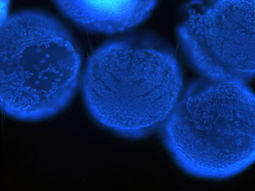Bisbenzimide  |
| Names |
| IUPAC name 2′-(4-Ethoxyphenyl)-6-(4-methyl-1-piperazinyl)-1H,3′H-2,5′-bibenzimidazole |
| Other names Hoechst 33342; Hoe 33342 |
| Identifiers |
| | |
3D model (JSmol) | |
| ChemSpider | |
| ECHA InfoCard | 100.041.523  |
| | |
| UNII | |
| | |
InChI=1S/C27H28N6O/c1-3-34-21-8-4-18(5-9-21)26-28-22-10-6-19(16-24(22)30-26)27-29-23-11-7-20(17-25(23)31-27)33-14-12-32(2)13-15-33/h4-11,16-17H,3,12-15H2,1-2H3,(H,28,30)(H,29,31) Key: PRDFBSVERLRRMY-UHFFFAOYSA-N InChI=1/C27H28N6O/c1-3-34-21-8-4-18(5-9-21)26-28-22-10-6-19(16-24(22)30-26)27-29-23-11-7-20(17-25(23)31-27)33-14-12-32(2)13-15-33/h4-11,16-17H,3,12-15H2,1-2H3,(H,28,30)(H,29,31) Key: PRDFBSVERLRRMY-UHFFFAOYAR
|
SMILES CCOc1ccc(cc1)c2[nH]c3cc(ccc3n2)c4[nH]c5cc(ccc5n4)N6CCN(CC6)C
|
| Properties |
| | C27H28N6O |
| Molar mass | 452.562 g·mol−1 |
Except where otherwise noted, data are given for materials in their standard state (at 25 °C [77 °F], 100 kPa). |
| | |
Bisbenzimide (Hoechst 33342) is an organic compound used as a fluorescent stain for DNA in molecular biology applications.[1] Several related chemical compounds are used for similar purposes and are collectively called Hoechst stains.
Application
Bisbenzimide tends to bind to adenine–thymine-rich regions of DNA and can decrease its density. Bisbenzimide mixed with DNA samples can then be used to separate DNA according to their AT percentage using a cesium chloride (CsCl) gradient centrifugation.

Nuclei of Platynereis dumerilii larvae stained with Hoechst 33342
References
External links
This article is copied from an
article on Wikipedia® - the free encyclopedia created and edited by its online user community. The text was not checked or edited by anyone on our staff. Although the vast majority of Wikipedia® encyclopedia articles provide accurate and timely information, please do not assume the accuracy of any particular article. This article is distributed under the terms of
GNU Free Documentation License.
All content on this website, including dictionary, thesaurus, literature, geography, and other reference data is for informational purposes only. This information should not be considered complete, up to date, and is not intended to be used in place of a visit, consultation, or advice of a legal, medical, or any other professional.

